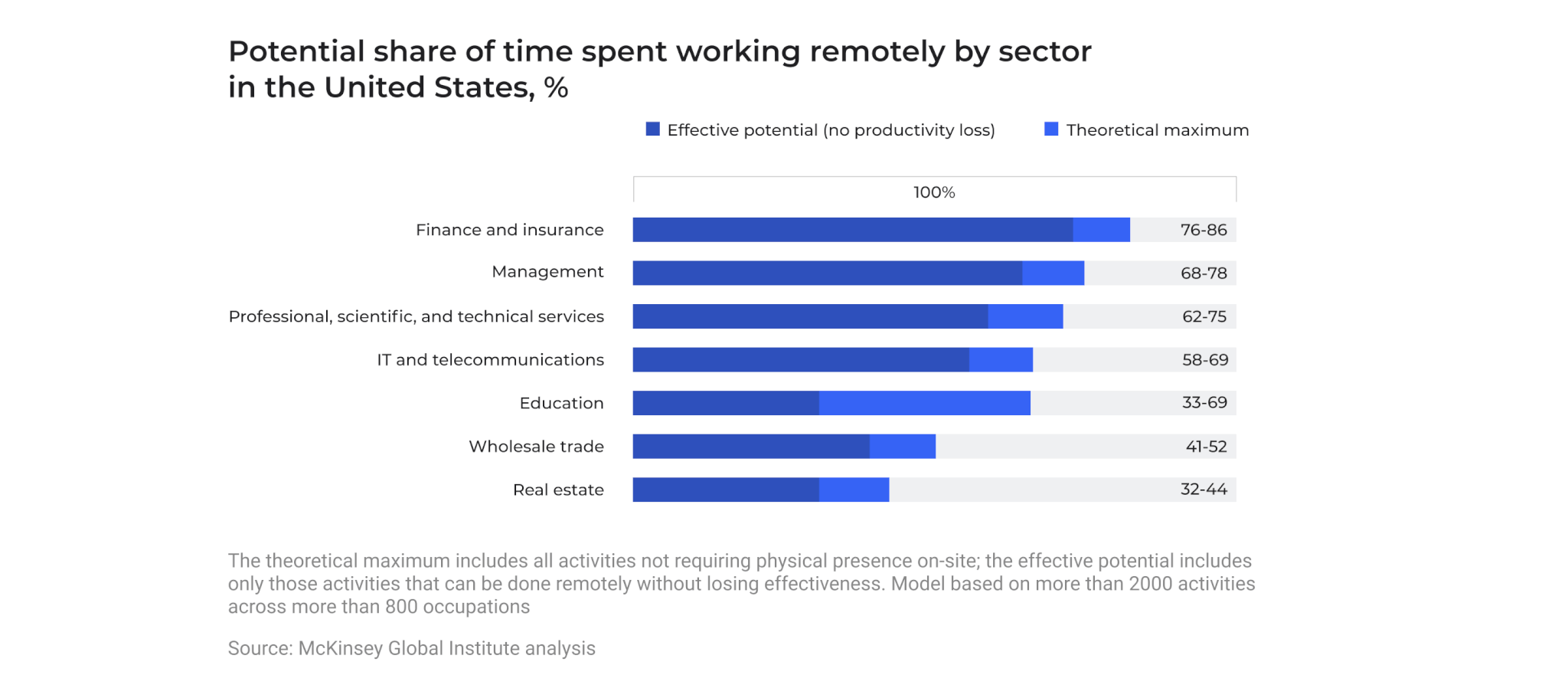Data professionals: An overview of specialisations and responsibilities
The market demand for data specialists is growing in proportion to the growth in data volumes. Let’s discuss the areas of responsibility, core competencies and skills.
With the outburst of COVID-19, it seemed that remote work was here to stay even in the post-pandemic — but currently, some of the leading figures in the corporate world are rallying to get their employees back in their offices.
The global pandemic forced businesses to adapt quickly, and while this transformation has proven successful for many organizations, the post-pandemic work environment also raised new challenges. Companies that have been forced into remote-work arrangements for the past year now face a complicated decision: Should companies let employees work remotely, bring them back to the offices or find a solution in between?
With vaccines becoming more widely available in some regions, many offices are opening their doors to allow, or in some cases require, workers to return. While companies from Google to Ford Motor Co. and Citigroup Inc. have promised greater flexibility, many chief executives have publicly extolled the importance of being in offices.
Some have lamented the perils of remote work, saying it diminishes collaboration and company culture. James Gorman, CEO of Morgan Stanley, one of Wall Street’s top investment banks, said that it’s time for the bank’s employees to head back to the offices. CEO of We Work Sandeep Mathrani stated that “those who are least engaged are very comfortable working from home”, stressing the importance to return to the offices this fall.
Moreover, in a recent article, Harvard Business Review pointed out that in-person work could significantly benefit employees, not to mention the company. And there are signs that some of the employees are ready to return to in-person work. Twenty-six per cent ranked socialisation at the physical office as the most important aspect of in-person work, while another 35% felt it was collaboration. Many are excited to return to work for interpersonal connection yet desire the continued flexibility to work remotely in some capacity.
Still, the majority of employees aren’t so sure. If anything, the past year has proven that lots of work can be done from anywhere, sans lengthy commutes on crowded trains or highways. Some people have moved. Others have lingering worries about the virus and vaccine-hesitant colleagues.
While Apple and Uber have adopted more rigid policies, requiring employees to be back in their pre-pandemic office at least three days a week, Google and Twitter have taken a different approach. Google is asking workers to choose between permanently staying remote, coming back to the office or switching office locations. Twitter is giving its employees the option to stay remote forever if their role allows it.
Many employees have expressed that they’ve been more productive working from home and hope to continue doing much of their work remotely in the post-pandemic. Among the many reasons people prefer working from home is that commuting has been eliminated. It makes it easier for people to choose the hours they want to work and schedule their work time around other responsibilities, like caring for their children. For many, the personal drawbacks, such as difficulties in maintaining work-life balance, pale in comparison to these benefits.
Remote work in the post-pandemic will likely continue at significantly higher rates than before the pandemic. In surveys conducted by Forbes, 72% of executives claimed that their companies adopted the remote-work model permanently. At the same time, 70% of employees stated that working from home is the major criterion in selecting the next workplace.
To determine how extensively remote work may persist in the post-pandemic, McKinsey Global Institute analysed more than 2,000 tasks used in 800 occupations in eight focus countries. It was found that even after vaccines are fully rolled out and workplaces return to the new normal, 22% of U.S. jobs could be done remotely for 3–5 days a week, and 17% of jobs could be done remotely 1–3 days a week — without loss of productivity. The remaining 61% of jobs could be done remotely only for one day a week or less.

Most newly remote companies pivoted because of the COVID-19 pandemic. But to continue remote work after the pandemic, companies must ask themselves, “Why are we doing this?” There are a few reasons companies may choose to continue allowing employees to work in the post-pandemic remotely:
Some companies may also take steps to realign their workforce numbers with a changing business landscape. They may resort to more permanent workforce reductions, including furloughs, lay-offs or increasing the use of contract workers to match their business needs and maintain profitability.
Enabling employees to achieve work-life balance will go a long way in ensuring that they maintain productivity and engagement. A recent Accenture research study on the future of work stated that employees who had a hybrid work situation during the pandemic “had better mental health, stronger work relationships, and was more likely to feel net better off and less burned out working for their organizations.”
Taking that into account, it may be stated that where people work is a lot less important than how they can be most productive — both personally and professionally. People need to have balance to be their best selves, and chief executives must trust them to make those decisions.
Thus, Facebook CEO Mark Zuckerberg announced that the company will allow all full-time employees to work from home if their jobs can be done remotely. The company said it would likely open most of its U.S. offices at half capacity in September, and then fully in October. Once that occurs, employees who haven’t received approval to continue working remotely will be expected to come into the office, at minimum, 50% of the time.
This is a change from the plans Facebook announced in May 2020, when the company said it would allow certain employees, notably their most senior and experienced employees, to request permanent remote work. It should be noted that effective remote work is correlated with the experience the employees possess — those who do not need to be mentored and trained are more effective remote workers. As a result, leading companies in the industry are choosing remote or hybrid models; most of their employees do not require micromanagement and are able to tackle issues effectively, even if working remotely.
Additionally, Zuckerberg said Facebook will begin allowing employees to request remote work across international borders. It seems very clear that companies that embrace remote work—prioritising flexibility and skill over physical presence — will have access to a significantly larger pool of talent relative to pre-pandemic times.
At SSA Group, we’re seeing that many of our employees have become accustomed to the benefits of the hybrid workplace model. Being an IT service provider situated in Ukraine, our specialists work remotely for our international clients, and the ability to return to the office a few days a week helps employees to discuss work-related issues in person and come up with the best solution.
SSA Group can adhere to the hybrid workplace model because 80% of our employees are strong middle- and senior-level specialists. Additionally, the company has detailed business processes for the major activities that help employees work according to clear guidelines.
The hybrid business model can combine the advantages of remote work and collaboration opportunities of face-to-face work in an office. To the organization the hybrid model brings the following benefits:
The leading tech companies have spent considerable time building highly convenient campuses for their employees to stimulate the exchange of ideas and personal interaction. However, the COVID-19 pandemic revealed that employees can be as efficient — and in some cases more productive — by working remotely.
A recent survey confirmed that the rise of remote work is likely to continue, with 77% of people expecting to work at least three days a week remotely. Specific occupations where remote working levels were already high before the pandemic have an increased likelihood of continued remote work.
Since leaders around the world experiment with bringing their stuff back to the offices, they need to be sure that the workplaces are both productive and safe. Depending on the business model and industry, organisations should be prepared to break from the traditional notion of office work as online meetings have become an inevitable part of our day-to-day life.
Thank you for getting to the end of this article. If you have any questions, please, feel free to write to us. We appreciate your feedback and will answer you in the clearest and most precise way. Consider the experienced IT consultants from SSA Group to support your software development plans and business growth.

The market demand for data specialists is growing in proportion to the growth in data volumes. Let’s discuss the areas of responsibility, core competencies and skills.

When starting a new project, one of the crucial questions is whether to hire an individual contractor, an IT service provider or build an in-house dev team.
you're currently offline